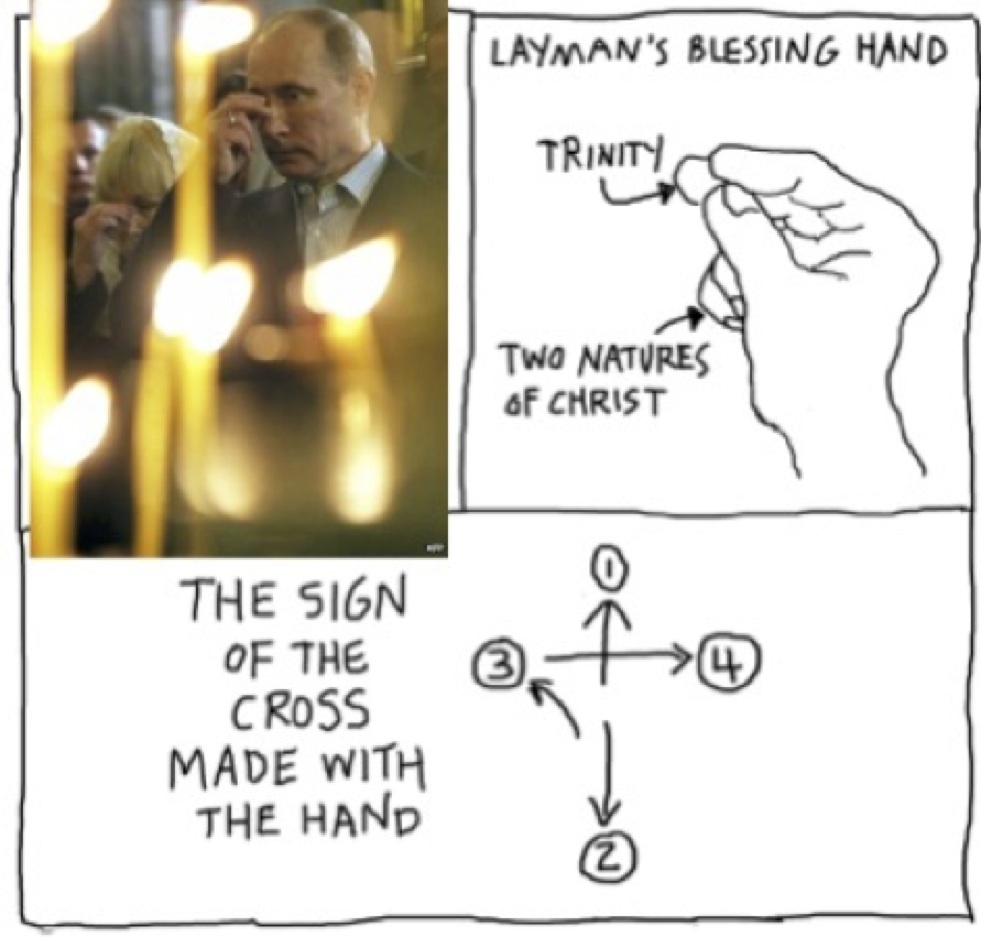![]() While I was spending my summer in Poland, someone brought an interesting blog article to my attention. It has now been scientifically proven that making the sign of the cross over an amount of water significantly diminishes the amount of bacterial pathogens in that water. Is the making of the sign of the cross a matter of antibacterial hygiene just as much as it is a matter of piety?
While I was spending my summer in Poland, someone brought an interesting blog article to my attention. It has now been scientifically proven that making the sign of the cross over an amount of water significantly diminishes the amount of bacterial pathogens in that water. Is the making of the sign of the cross a matter of antibacterial hygiene just as much as it is a matter of piety?
Searching on the internet it soon became apparent that several Polish blogs had reported about this in the past few years. Evidently this is the kind of “novelty” that one needs to fall back on during the slow news season.
The earliest source that I could initially find for all of this was a release from the Russian press agency Interfax. There do not appear to be any articles in any scientific journals. But the physicist behind all of this, Angelina Malakhovskaya, reports about her findings in a book: “How do the Healing Properties of Holy Water, Eastern-Orthodox Prayer and the Sign of the Cross Manifest Themselves?”

According to this last webpage Angelina Malakhovskaya was affiliated with the Laboratory for Medical-Biological Technology of the Scientific Research Institute for Industrial and Maritime Medicine in Saint Petersburg. This particular lab no longer exists, but a quick glance at webarchive reveals that their focus was on vague subjects like bioresonance and quantum physiotherapy. It also appears that Angelina is a member of the Alliance of Eastern Orthodox Scientists in Russia.
Antiseptic and Murky
Angelina and her co-workers took water from a well, from a pond, and from a river. Making the sign of the cross would decrease the number of bacterial pathogens by a factor of 7, 10, 100, or 1000. However, if the sign of the cross was made by an infidel, the effect is about 10% less.
The sign of the cross is associated with “The Light.” That’s why also optical properties of water were altered after the sign of the cross is made. The claim is a bit bizarre: over a small range in the ultraviolet part of the spectrum, the optical density of the water increases. When an ordinary believer makes the sign, it’s an increase by a factor of 1½. However, in case the sign is made by a cleric, the effect is enhanced and the factor is 2½.
The term “optical density” is just as unusual as it is vague. The term is sometimes used for the refractive index and sometimes for the absorption coefficient. The index of refraction describes how a ray of light changes direction when it goes from one medium to another. It’s why lenses work and it’s standard high school physics. The absorption coefficient indicates what fraction of the light is absorbed by a material when a ray of that light goes through one meter of that material. It is common practice in physics to put the index of refraction and the absorption coefficient together is one so-called complex number.
After some searching I discovered that Angelina’s magic interval in the ultraviolet spectrum runs from a wavelength of 200 nm to a wavelength of 240 nm. The symbol “nm” stands for nanometer. A nanometer is a billionth of a meter. Visible light covers the interval from 400 nm (purple light) to 700 nm (red light). Ultraviolet light has a smaller wavelength than visible light.
The factor of 2½ sounds impressive, but it is not that significant if by “optical density” Angelina means “absorption coefficient.” For light with a wavelength of 200 nm the absorption coefficient is about one. The increase by a factor of 2½ means that a centimeter of water passes 97.5% of the light instead of 99%.
In case “optical density” as used by Angelina refers to “index of refraction,” it would mean that this index increases in value from 1.4 (the “normal” value that is given in the literature) to 3.5 after a sign of the cross by a cleric. The index of refraction of a medium also indicates by what factor the speed of light slows down when it enters that medium from the air. The 2½ therefore means that the speed of light in water would slow down with a factor 3.5 instead of 1.4.
Finally, from a religious perspective it is bizarre that the sign of the cross increases the index of refraction and/or the absorption coefficient. Suppose that the optical density means the absorption coefficient. An increasing absorption of light implies that the cross does not have an illuminating effect, but, instead, makes matters darker and more murky. If the optical density is the index of refraction, then the factor of 2½ means that, after the sign of the cross, “The Light” propagates and spreads with a speed that is a factor of 2½ lower.
Which Sign of the Cross?
In many of the articles and blogs we are told that Angelina’s research also shows that it is important that the sign of the cross is made correctly. A wrong gesture or a carelessly made sign of the cross would have no effect.

Here we are running into some intra-Christian controversy. As shown in the illustrations, the Catholic and the Eastern Orthodox Church make the sign of the cross in very different ways.
On a Serbian blog of 2008 it is emphasized how Malakhovskaya’s effects only occur when the Eastern Orthodox sequence is carefully followed. If it is only the Eastern Orthodox sign of the cross that has miraculous effects, then the Catholic gestures have to be without any effect. It is peculiar that the Catholic Polish blogosphere has completely overlooked this problem.

About Angelina and her “Book”
Googling the name “Angela Malakhovskaya,” I ran into tens of pages with articles about the scientifically researched effects of the sign of the cross. The articles were in Polish, English, Romanian, Hungarian, and Serbo-Croatian. Trying other transcriptions of the name (Malahovska, Malahovskaja, Malakhovskaja) led to similar results. What I did not find were scientific articles on which Angelina Malakhovskaya was an author or co-author. That is a bit odd for someone who works, or worked, at a scientific institute. I would also have loved to have a look at that book. I was actually ready to order it. But, unfortunately, my googling on the book’s title led to no results.
One does not have to be a pathological skeptic to get suspicious at that point.
Anna Ochab-Marcinek maintains a blog “being a young physicist”. She had written about Angelina’s findings and their proliferation outside Russia. The Russian language uses a Cyrillic alphabet. Therefore Russian websites don’t pop up when one googles with Latin letters. But with Anna’s help I found some Russian websites that shed light on the situation.
In 2010 Grigori Tarashevich wrote a very critical article “Can Eastern Orthodoxy Kill Bacteria?” The subtitle leaves no doubt about Grigori’s conclusion “The author of a spectacular discovery turns out to be a fraud.” He actually called the head of the laboratory where Angelina was supposed to have worked. At the end of the article we read: I managed to get the cell phone number of the head of the laboratory where Angelina worked according to the press. He was actually vacationing in the Tver region at that moment, but he did not mind making a roaming call and he was willing to comment on the unique research of his employee: – What? Angelina Malakhovaskaya? She never worked at our place. But she presented herself everywhere as a member of our lab. She only brings shame to our institute. I know her. She is a very pushy lady. She did some research, but she never got anywhere. Water is an interesting subject, but what Malakhovskaya says, that has nothing to do with science. You know, I got the impression that she … well, I really don’t have the right to say anything about it. After all, I am not a psychiatrist.
On a 2013 blog by the “tech-nomad” I found a number of scanned pages from Angelina’s book. It was here that I ultimately found out that the magic range in the ultraviolet spectrum was between 200 nm and 240 nm. And here it also became immediately clear why the book had been so hard to find on the internet. It’s nothing more than a stenciled leaflet. There is an actual YouTube video where Angelina reads from her leaflet and provides further explanation.
The Nature of a Miracle
Angelina’s work is food for thought for those who are philosophically inclined. The title of the aforementioned YouTube video is A Drop of Holy Water Creates a Miracle. Also on the scanned pages, I found the Russian word for “miracle.”
In the 18th century the Scottish philosopher David Hume tried to describe what, from a scientific perspective, exactly constitutes a miracle. A miracle has to involve a violation of laws of nature. If that’s not the case we are simply dealing with everyday reality.
A rock that is falling down is the usual and predictable state of affairs. A rock that should fall down, but, instead, keeps floating without any apparent reason – that would be a miracle. However, suppose you find conditions under which the rock always stays afloat. In that case the state of floating is reproducible. Floating is then no longer miraculous. In that case it would actually be a miracle if the rock falls down under conditions in which it should be floating.
Angelina Malakhovskaya pretends to have discovered a reproducible effect. The word “miracle” should in that situation no longer be used.
As a matter of fact, there should not be a place at all in science for the word “miracle.”
A Fifth Column
Angelina’s research is of a certain kind. A few years ago I ran into an Algerian study that showed how healthier poultry results if chickens are slaughtered while Islamic prayer is recited. It all feels like a merger of religious fervor and bad science. Angelina is a lot like Gladyshev in the famous satire by Vladimir Voinovich “The Life and Extraordinary Adventures of Private Ivan Chonkin.” The impassioned Gladyshev is intent on crossbreeding tomato and potato plants in order to come to a hybrid that grows tomatoes on top and potatoes at the bottom.

Angelina, the Algerian research group, and the Catholic Polish bloggers – all of them most certainly operate under the assumption that their published findings will inspire their reading audience to new piousness. But there is good ground to fear that the happy marriage between science and religion that they think they are achieving is a failure from the outset.
Religious ritual consists for a large part of inconveniences, risks, and sacrifices without a rational explanation about any possible benefit. Circumcision, prayer, fasting, pilgrimage, tithing, etc. – these are investments in the company called “God”; investments that are made in the assumption that they will lead to favorable treatment by a supernatural entity. It’s precisely through following a ritual that has no logically reasoned usefulness that one expresses belief in a higher power – a power that is not of this world. With her assertion that making the sign of the cross is something like brushing one’s teeth, i.e. a simple investment in one’s health, Angelina undermines the faith in an influenceable superhuman power. If the making of the sign of the cross is merely a matter of daily hygiene, then nothing has to be “believed” and sacrificed anymore. God may then just as well not exist anymore.
Hollowing out faith from the inside – that’s actually what Angelina, the Algerian researchers, and the Catholic Polish bloggers are doing. Without being aware of it, they are a fifth column for the Richard Dawkins Foundation.

Very good to have this in English as well. It would be terrific if everything on kloptdatwel.nl would be available in Dutch and English. ?